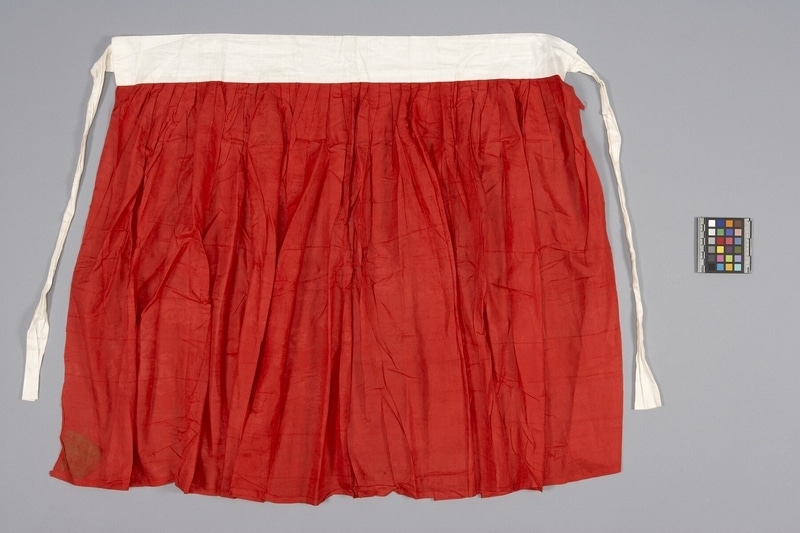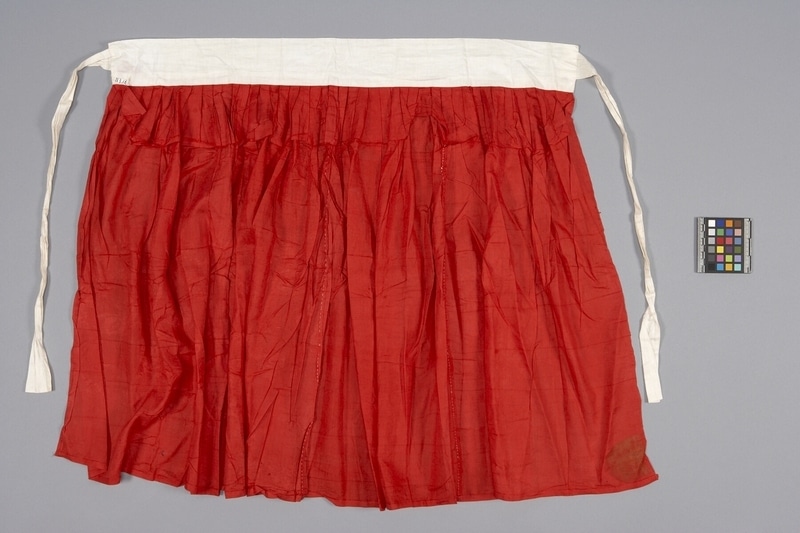Child's Skirt Item Number: N3.16 from the MOA: University of British Columbia


Description
Child’s skirt “chima” opening at the back, made of four panels of fine red silk sewn with running stitches of white thread, pleated onto a white waistband with ties at each end, also of fine silk. It opens completely at the back. The upper edge of the silk is turned under to the inside to a width of about 8 cm., with the rough edge of the fabric unfinished. There is a mark in the shape of a rounded triangle on the left lower corner. The pleated fabric is pulled up in the upper left corner higher than the rest into the waistband, thus raising the corresponding corner.
History Of Use
A skirt “chima” of this type might have been worn by a girl on a special day, such as visiting friends or elderly people. “Chima” of this size would have been worn by a girl aged six or seven. “Chima” of such lightweight fabric were worn in spring and summer. The fabric of “chima” was pulled up into the waistband at one end to raise the corresponding corner of the skirt so the wearer would not trip. After Korea was opened to the outside world in about 1894, missionaries pressured their female students to have straps to hold up their “chima”, to fit the missionaries’ ideas of decency. Such “chima” would have been worn with a jacket “chogori” with sleeves made of bands of rainbow colours, light green or yellow in colour. Such colours were worn by children and brides.
Specific Techniques
The hem and the proper left side edge of the skirt are pasted. The stitching at the waist is simple. It is entirely hand-sewn, but appears to have been hastily made. Skirt is pleated onto waistband.
Item History
- Made in Korea before 1939
- Collected between 1899 and 1939
- Owned by Marion Stephan before August 1964
- Received from Marion Stephan (Donor) during August 1964
What
- Name
- Child's Skirt
- Identification Number
- N3.16
- Type of Item
- skirt
- Material
- silk fibre, dye and paste adhesive
- Manufacturing Technique
- woven, dyed, cut, pleated, sewn and pasted
- Overall
- height 68.0 cm, width 155.0 cm
Who
- Culture
- Korean
- Previous Owner
- Marion Stephan
- Received from
- Marion Stephan (Donor)
Where
- Holding Institution
- MOA: University of British Columbia
- Made in
- Korea
When
- Creation Date
- before 1939
- Collection Date
- between 1899 and 1939
- Ownership Date
- before August 1964
- Acquisition Date
- during August 1964
Other
- Item Classes
- textiles
- Condition
- poor
- Accession Number
- 0113/0076